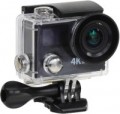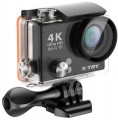HD (720p)
The ability of the camera to record HD video (720p).
The official HD specification provides a resolution of 1280x720. However, in action cameras, there may be resolutions slightly different from this parameter, for example, 1080x720 or 1440x960. Anyway, HD is the most modest of today's high-definition standards, which, nevertheless, provides a fairly clear and detailed image.
Another important parameter given in this paragraph is the frame rate. The higher it is, the smoother the movement in the frame will be, and the details in dynamic scenes will be visible clearly. Technically,
30 fps or even less is enough for video, but
60 fps is considered the perfect value — at this frame rate, motion blur becomes almost imperceptible and at the same time the size of the captured files remains within reasonable limits. However, there are cameras on the market with higher frame rates at HD resolutions —
100 fps,
120 fps,
200 fps and even
240 fps. This speed is usually used for recording slow-motion video, but such a possibility needs to be specified separately.
Ultra HD (4K)
The ability of the camera to shoot Ultra HD 4K video.
This format covers several resolutions in which the horizontal frame size is approximately 4K pixels. The most popular in action cameras is 3840x2160 (twice the FullHD frame on each side), but there are other options — for example, 3840x1920, corresponding to an aspect ratio of 2:1. In general, 4K is a kind of successor to Full HD: among HD standards that surpass Full HD, UltraHD is the most popular, in particular, many advanced TVs are produced with 3840x2160 screens. On the other hand, this format is quite demanding in terms of processing power and memory, so it is relatively rare in action cameras, mainly among premium models.
Another important parameter given in this paragraph is the frame rate. The higher it is, the smoother the movement in the frame will be, and the details in dynamic scenes will be visible clearly. However, in UltraHD mode, most modern action cameras produce a very low frame rate — most often
30 fps, and in some models
24 fps or even
15 fps. This video is quite viewable, but fast movement in the frame may look blurry. There are cameras capable of shooting UltraHD at a solid speed of
60 fps — the blurring effect during such shooting is almost imperceptible. However, such a model cost is high.
Slow motion
Frame rate supported by the camera when
shooting in slow motion.
In general, such shooting is called “high-speed” because it is carried out at an increased frame rate (more than 60 fps). As a result, when played back at normal speed (60 fps and below), the video looks slow hence the name. This kind of slow-motion can be used just for fun, as an artistic technique, and even for scientific purposes — to capture movement that is too fast for the human eye. In any case, the higher the slow-mo frame rate, the more you can slow down the video and the more advanced the camera is in this regard. On the other hand, the higher the frame rate, the more performant the graphics part should be; and this, in turn, affects the price of the device, sometimes quite noticeably.
We also note that slow-mo shooting may be available only at certain resolutions, not always at maximum. These points can be directly specified in the specs of the action camera.
Field of view
For models with several lenses, as a rule, this parameter is indicated for each lens.
Most often (unless otherwise indicated), the specifications indicate the field of view by the diagonal of the frame; in some
ultra-wide-angle lenses it can exceed 180°. A special case is made up of lenses for which a 360° view is declared: this means that the optics cover the entire hemisphere in front of it. Such lenses are found in panoramic and 360-degree cameras (see “Product type”).
In general, the field of view primarily determines what area of the scene is being captured into the frame. Accordingly, the wider it is, the more space the camera captures, and the lower the likelihood that something that is happening will be off-screen. On the other hand, it is worth considering that a strong increase in the field of view leads to distortions of the “picture”, especially at the edges, as well as, to a decrease in the size of visible objects and a decrease in detail. Detailed recommendations regarding choosing a camera based on this parameter can be found in special sources.
Megapixels
The number of megapixels in the action camera sensor, in other words, the resolution of this sensor(1 megapixel is 1 million photosensitive points).
There is an opinion that the higher the resolution, the better the image quality. It is true from the point of view that manufacturers are trying to install high-resolution sensors in advanced cameras. At the same time, there are no strict dependencies here, and from the technical point of view, the number of megapixels determines only the maximum image resolution that can be captured using this sensor. The quality of this picture will depend both on several features of the sensor itself (size, type, special design solutions), and the specs of the camera. So when choosing, you should focus not so much on the resolution of the image sensor, but on the general class of the camera and reviews with examples of footage.
Photo resolution
The maximum resolution at which the action camera can take photos. Specified in pixels horizontally and vertically.
This parameter is directly related to the resolution of the image sensor(see above): the total number of pixels in the photo, usually, corresponds to the number of pixels in the sensor. For example, a photo resolution of 4608x3456 corresponds to a sensor of 15925248 pixels, or approximately 16 megapixels. If the number of pixels in the photo is greater than the claimed resolution of the sensor, then the manufacturer uses software tricks that allow you to improve the photo resolution to a higher one than originally. This reduces the cost of devices but also affects the quality of images.
Theoretically, high-resolution images can provide good detail, but in fact, much depends on the specs of the sensor (primarily physical size) and image processing features.
Capabilities
—
Photo during video. The ability to take photos directly while recording a video — usually using a separate button. Thus, it is convenient to fix the most significant moments of what is happening. Such photos are much better in quality than "freeze frames" from the captured video.
—
Serial photo shoot. This feature allows you to take several pictures at once in a short period (usually it is a fraction of a second). A series of shots increases the chance of capturing a good moment, which can be very important given the specifics of using action cameras.
—
One click recording. The ability to quickly turn on the camera for recording — literally at the touch of a button, by the name. Moreover, such a button works even if the device is turned off. However, the recording inevitably starts with some delay; but often this delay is a fraction of a second.
—
Online streaming. Ability to stream video to popular services like YouTube and social networks (Facebook, Instagram, TikTok, etc.). Usually, the online streaming function is implemented when the action camera is connected to the Internet via a Wi-Fi network, less often via a wired connection. Communication with the World Wide Web can be held directly or through a smartphone or computer. It will require the use of appropriate software.
—
Time lapse. A special mode of operation of the action camera, in which video recording is carried out at a slower frequency is mainly used for filming slow processes. Thus, for example, a long journey or a long sunset can fit into a 3-minute video.
—
Auto-rotate. The function of automatic rotation of the captured photos and videos to the position corresponding to the position of the camera. Without this feature, all footage during playback would be displayed strictly in landscape orientation, and footage shot with the camera upside down or upside down would have to be rotated in a photo or video editor. Usually, at the beginning of video recording, auto-rotation is blocked — so that the position of the frame at any time corresponds to the rotation of the camera itself relative to its original position.
—
Photo panoramas shooting. The ability to use the camera to take panoramic photos. In traditional action cameras (see "Product type"), such shooting is carried out as follows: the camera takes several separate photos, which are then glued into one image. Regarding panoramic and 360-degree models (see ibid.), it is worth noting that not all such models support shooting in panoramic format, so it is advisable to check the availability of this function separately.
—
Key points labels. The ability to add special marks to the footage that indicate key moments. While viewing such videos, you can go directly to the labels — this is easier than manually searching for the right moment. This feature is especially useful when shooting long videos, as well as when numerous individual files. The label, usually, is placed right during the shooting by pressing a special button or by voice command.
—
Night shooting. Special mode for recording in low light conditions. The specific implementation of this function may be different: in some models, the sensitivity of the sensor is increased, in others, shooting in the IR range is used. Accordingly, specific features may vary: not every camera with this function can shoot in complete darkness, and these nuances should be clarified separately.
Display
— Diagonal. The larger the screen, the more convenient it is to watch (and also to control if the display is touch-sensitive). On the other hand, the diagonal of the
built-in display directly affects the size of the case, and action cameras should be quite compact. Thus, there are practically no screens larger than 2.5" in modern action cameras.
— Resolution. Theoretically, the higher the resolution, the clearer and better image the screen produces. On the other hand, displays in action cameras are designed mainly for menu operation and footage preview — and for these purposes, especially high resolutions are not needed. For models with two screens, the rear display is considered the main display.
— Touch screen. Display equipped with a sensor and responsive to touch like in smartphones/tablets. Control through such a display is simpler and more intuitive than using buttons, rotary knobs, etc. On the other hand, for more or less convenient control, the
touch screen must be quite large, which affects the dimensions of the entire camera.
Front screen
The presence in the camera of a screen mounted on the front panel, next to the lens. Other displays may not be present at all; in such cases, the diagonal, resolution and other parameters are given for
the front screen.
It is worth noting that most often the simplest black-and-white displays are installed on the front panel, suitable only for text and basic graphic information. However, even on such a screen, you can display a wide variety of service data: the current mode of operation (photo, video, standby), the resolution used, the shooting time, the amount of free space on the drive, etc. But more advanced displays are not used as front displays: a full-colour screen is needed only for taking a selfie, and for this you can use a
remote display with a remote control(see "Control") or a smartphone connected to the camera.

